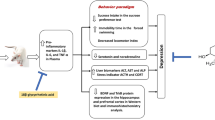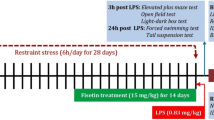Abstract
Purpose
Stress exposure elicits neuroinflammation and oxidative damage in brain, and stress-related neurological and neuropsychiatric diseases have been associated with cell damage and death. Mangiferin (MAG) is a polyphenolic compound abundant in the stem bark of Mangifera indica L. with antioxidant and anti-inflammatory properties in different experimental settings. In this study, the capacity of MAG to prevent neuroinflammation and brain oxidative damage induced by stress exposure was investigated.
Methods
Young–adult male Wistar rats immobilized during 6 h were administered by oral gavage with increasing doses of MAG (15, 30, and 60 mg/Kg), respectively, 7 days before stress.
Results
Prior treatment with MAG prevented all of the following stress-induced effects: (1) increase in glucocorticoids (GCs) and interleukin-1β (IL-1β) plasma levels, (2) loss of redox balance and reduction in catalase brain levels, (3) increase in pro-inflammatory mediators, such as tumor necrosis factor alpha TNF-α and its receptor TNF-R1, nuclear factor-kappa B (NF-κB) and synthesis enzymes, such as inducible nitric oxide synthase (iNOS) and cyclooxygenase-2 (COX-2), (4) increase in lipid peroxidation.
Conclusions
These multifaceted protective effects suggest that MAG administration could be a new therapeutic strategy in neurological/neuropsychiatric pathologies in which hypothalamic/pituitary/adrenal (HPA) stress axis dysregulation, neuroinflammation, and oxidative damage take place in their pathophysiology.





Similar content being viewed by others
References
Madrigal JLM, Caso J, Hurtado O et al (2004) Brain oxidative markers in stress. Possible new drug targets against neuroinflammation. Curr Neuropharmacol 2:183–189
García-Bueno B, Caso J, Pérez-Nievas BG et al (2006) Effects of peroxisome proliferator-activated receptor gamma agonists on brain glucose and glutamate transporters after stress in rats. Neuropsychopharmacology 32:1251–1261
García-Bueno B, Caso JR, Leza JC (2008) Stress as a neuroinflammatory condition in brain: damaging and protective mechanisms. Neurosci Biobehav Rev 32:1136–1151
Shelton RC, Claibome J, Sidoryk-Wegrzynowicz M et al (2010) Altered expression of genes involved in inflammation and apoptosis in frontal cortex in major depression. Mol Psychiatry (Epublication ahead of print version)
Galasko D, Montine TJ (2010) Biomarkers of oxidative damage and inflammation in Alzheimer’s disease. Biomark Med 4:27–36
Zunszain PA, Anacker C, Cattaneo A et al (2010) Glucocorticoids, cytokines and brain abnormalities in depression. Prog Neuropsychopharmacol Biol Psychiatry (Epublication ahead of print version)
Potvin S, Stip E, Sepehry AA, Gendron A et al (2008) Inflammatory cytokine alterations in schizophrenia: a systematic quantitative review. Biol Psychiatry 63:801–808
Bierhaus A, Wolf J, Andrassy M et al (2003) A mechanism converting psychosocial stress into mononuclear cell activation. Proc Natl Acad Sci USA 100:1920–1925
Madrigal JL, Hurtado O, Moro MA et al (2002) The increase in TNF-alpha levels is implicated in NF-kappaB activation and inducible nitric oxide synthase expression in brain cortex after immobilization stress. Neuropsychopharmacology 26:155–163
Madrigal JL, Olivenza R, Moro MA et al (2001) Glutathione depletion, lipid peroxidation and mitochondrial dysfunction are induced by chronic stress in rat brain. Neuropsychopharmacology 24:420–429
Olivenza R, Moro MA, Lizasoain I et al (2000) Chronic stress induces the expression of inducible nitric oxide synthase in rat brain cortex. J Neurochem 74:785–791
Pacher P, Beckman JS, Liaudet L (2007) Nitric oxide and peroxynitrite in health and disease. Physiol Rev 87:315–324
Keller JN, Mattson MP (1998) Roles of lipid peroxidation in modulation of cellular signaling pathways, cell dysfunction, and death in the nervous system. Rev Neurosci 9:105–116
McEwen BS (2008) Central effects of stress hormones in health and disease: understanding the protective and damaging effects of stress and stress mediators. Eur J Pharmacol 583(2–3):174–185
Chi CW, Wang CN, Lin YL et al (2005) Tournefolic acid B methyl ester attenuates glutamate-induced toxicity by blockade of ROS accumulation and abrogating the activation of caspase and JNK in rat cortical neurons. J Neurochem 92:692–700
Kanada A, Nishimura Y, Yamaguchi JY et al (2005) Extract of Ginkgo biloba Leaves attenuates kainate-induced increase in intracellular Ca2+ concentration of rat cerebellar granule neurons. Biol Pharm Bull 28:934–936
Núñez Selles AJ, Velez H, Aguero J et al (2002) Isolation and quantitative analysis of phenolic antioxidants, free sugars, and polyols from mango (Mangifera indica L.) stem bark aqueous decoction used in Cuba as nutritional supplement. J Agric Food Chem 50:762–766
Nuñez AJ, Durruthy MD, Rodríguez E et al (2007) Comparison of major and trace element concentration in sixteen varieties of Cuban mango stem bark (Mangifera indica L.). J Agric Food Chem 55:2176–21781
Martínez G, Delgado R, Perez G et al (2000) Evaluations of the in vitro antioxidant activity of Mangifera indica L. extract (Vimang). Phytother Res 14:424–427
Garrido G, González D, Delporte C et al (2001) Analgesic and anti-inflammatory effects of Mangifera indica L. extract (Vimang). Phytother Res 15:18–21
Márquez L, Pérez-Nievas BG, Gárate I et al (2010) Anti-inflammatory effects of Mangifera indica L. extract in a model of colitis. World J Gastroenterol 16:4922–4931
Gottlieb M, Leal-Campanario R, Campos-Esparza MR et al (2006) Neuroprotection by two polyphenols following excitotoxicity and experimental ischemia. Neurobiol Dis 23:374–386
Jung K, Lee B, Han SJ et al (2009) Mangiferin ameliorates scopolamine-induced learning deficits in mice. Biol Pharm Bull 32:242–246
Pardo Andreu GL, Maurmann N et al (2010) Mangiferin, a naturally occurring glucoxilxanthone improves long-term object recognition memory in rats. Eur J Pharmacol 635:124–128
Liu Y, Xu F, Zeng X et al (2010) Application of a liquid chromatography/tandem mass spectrometry method to pharmacokinetic study of mangiferin in rats. J Chromatogr B Anal Technol Biomed Life Sci 878:3345–3350
Hou Y, Fan S, Zhang H et al (2010) Pharmacokinetic study of mangiferin in rat plasma and retina using high-performance liquid chromatography. Mol Vis 16:1659–1668
Yu-Juan L, Ying-Jie S, Yue-Han D, Yu-Lin DLC (2008) Determination and pharmacokinetics study of mangiferin in rat plasma and tissues. Chromatographia 67(11–12):957–960
Bhattacharya SK, Ghosal S, Chaudhuri RK, Sanyal AK (1972) Canscora decussata (Gentianaceae) xanthones. 3. Pharmacological studies. Pharm Sci 61(11):1838–1840
Leza JC, Salas E, Sawicki G et al (1998) The effects of stress on homeostasis in JCR-LA-cp rats: the role of nitric oxide. J Pharmacol Exp Ther 286:1397–1403
de Pablos RM, Villarán RF, Argüelles S et al (2006) Stress increases vulnerability to inflammation in the rat prefrontal cortex. J Neurosci 26:709–719
Radley JJ, Williams B, Sawchenko PE (2008) Noradrenergic innervation of the dorsal medial prefrontal cortex modulates hypothalamo-pituitary-adrenal responses to acute emotional stress. J Neurosci 2:5806–5816
Das NP, Ratty AK (1987) Studies on the effects of the narcotic alkaloids, cocaine, morphine, and codeine on nonenzymatic lipid peroxidation in rat brain mitochondria. Biochem Med Metabol Biol 37:258–264
Schreiber E, Matthias P, Müller MM et al (1989) Rapid detection of octamer binding proteins with ‘mini-extracts’, prepared from a small number of cells. Nucleic Acid Res 17:6419
Li M, Wang Y, Guo R et al (2007) Glucocorticoids impair microglia ability to induce T cell proliferation and Th1 polarization. Immunol Lett 109:129–137
Nair A, Hunzeker J, Bonneau RH (2007) Modulation of microglia and CD8(+) T cell activation during the development of stress-induced herpes simplex virus type-1 encephalitis. Brain Behav Immun 21:791–806
Sorrells SF, Sapolsky RM (2007) An inflammatory review of glucocorticoid actions in the CNS. Brain Behav Immun 21:259–272
Dinkel K, MacPherson A, Sapolsky RM (2003) Novel glucocorticoid effects on acute inflammation in the CNS. J Neurochem 84:705–716
MacPherson A, Dinkel K, Sapolsky R (2005) Glucocorticoids worsen excitotoxin- induced expression of pro-inflammatory cytokines in hippocampal cultures. Exp Neurol 194:376–383
Garcia-Fernandez LF, Iniguez MA, Eguchi N et al (2000) Dexamethasone induces lipocalin-type prostaglandin D synthase gene expression in mouse neuronal cells. J Neurochem 75:460–470
Besedovsky H, del Rey A, Sorkin E et al (1986) Immunoregulatory feedback between interleukin-1 and glucocorticoid hormones. Science 233:652–654
Sapolsky R, Rivier C, Yamamoto G et al (1987) Interleukin-1 stimulates the secretion of hypothalamic corticotropin-releasing factor. Science 238:522–524
Bartfai T, Sánchez-Alavez M, Andell-Jonsson S et al (2007) Interleukin-1 system in CNS stress: seizures, fever, and neurotrauma. Ann N Y Acad Sci 1113:173–177
Skinner RA, Gibson RM, Rothwell NJ et al (2009) Transport of interleukin-1 across cerebromicrovascular endothelial cells. Br J Pharmacol 156:1115–1123
Licinio J, Wong ML (1997) Pathways and mechanisms for cytokine signaling of the central nervous system. J Clin Invest 100:2941–2947
Lucas SM, Rothwell NJ, Gibson RM (2006) The role of inflammation in CNS injury and disease. Br J Pharmacol 147:S232–S240
Song C, Phillips AG, Leonard B (2003) Interleukin 1 beta enhances conditioned fear memory in rats: possible involvement of glucocorticoids. Eur J Neurosci 18:1739–1743
Campos-Esparza MR, Sánchez-Gómez MV, Matute C (2009) Molecular mechanisms of neuroprotection by two natural polyphenols. Cell Calcium 45:358–368
García D, Delgado R, Ubeira FM et al (2002) Modulation of rat macrophages function by the Mangifera indica L. extracts Vimang and mangiferin. Int Immunophar 2:797–806
Mishra B, Indira K, Sudheerkumar M et al (2006) Pulse radiolysis study of mangiferin: a C-glycosyl xanthone isolated from Mangifera indica. Rad Phys Chem 75:70–77
Madrigal JL, Moro MA, Lizasoain I et al (2003) Induction of cyclooxygenase-2 accounts for restraint stress-induced oxidative status in rat brain. Neuropsychopharmacology 28:1579–1588
Leiro J, García D, Arranza JA et al (2004) An Anacardiaceae preparation reduces the expression of inflammation-related genes in murine macrophages. Int Immunophar 4:991–1003
Garrido G, Delgado R, Lemus Y et al (2004) Protection against septic shock and suppression of tumor necrosis factor alpha and nitric oxide production on macrophages and microglia by a standard aqueous extract of Mangifera indica L. (VIMANG®). Role of mangiferin isolated from the extract. Pharmacol Res 50:165–172
Ahmed S, Rahman A, Hasnain A et al (2002) Green tea polyphenol epigallocatechin-3-gallate inhibits the IL-1 beta-induced activity and expression of cyclooxygenase-2 and nitric oxide synthase-2 in human chondrocytes. Free Radic Biol Med 33:1097–1105
Hong J, Smith TJ, Ho CT et al (2001) Effects of purified green and black tea polyphenols on cyclooxygenase and lipoxygenase dependent metabolism of arachidonic acid in human colon mucosa and colon tumor tissues. Biochem Pharmacol 62:1175–1183
Madrigal JL, García-Bueno B, Caso JR et al (2006) Stress-induced oxidative changes in brain. CNS Neurol Disord Drug Targets 5:561–568
Allan SM, Rothwell NJ (2003) Inflammation in central nervous system injury. Phil Trans R Soc Lond B Biol Sci 358:1669–1677
Hallenbeck JM (2002) The many faces of tumor necrosis factor in stroke. Nat Med 8:1363–1368
Madrigal JL, Moro MA, Lizasoain I et al (2001) Inducible nitric oxide synthase expression in brain cortex after acute restraint stress is regulated by nuclear factor kappaB-mediated mechanisms. J Neurochem 76:532–538
Caso JR, Lizasoain I, Lorenzo P et al (2006) The role of TNF α in stress-induced worsening of cerebral ischaemia in rats. Neuroscience 142:59–69
Leiro J, Arranz JA, Yáñez M et al (2004) Expression profiles of genes involved in the mouse nuclear factor-kappa B signal transduction pathway are modulated by mangiferin. Int Immunopharmacol 4:763–778
Acknowledgments
Supported by Spanish Ministry of Education (MEC, SAF07-63138), the Instituto de Salud Carlos III, Centro de Investigación en Red de Salud Mental, CIBERSAM, and Foundation Santander-UCM (GR 58/08). Lucía Márquez is recipient of a fellowship from Programme Alßan, European Commission.
Conflict of interest
The authors declare that there are no conflicts of interest.
Author information
Authors and Affiliations
Corresponding author
Rights and permissions
About this article
Cite this article
Márquez, L., García-Bueno, B., Madrigal, J.L.M. et al. Mangiferin decreases inflammation and oxidative damage in rat brain after stress. Eur J Nutr 51, 729–739 (2012). https://doi.org/10.1007/s00394-011-0252-x
Received:
Accepted:
Published:
Issue Date:
DOI: https://doi.org/10.1007/s00394-011-0252-x




